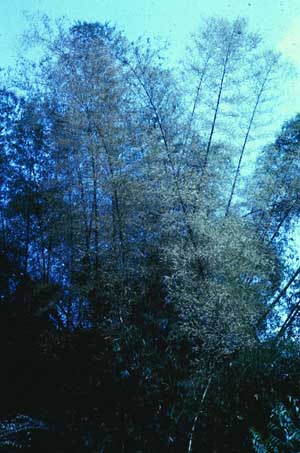|
|
 12 bamboo reproduction DHJanzen100403.jpg high resolution
|
|
|
And then one year the bamboo sends up - instead of leafy stems - stems that bear millions of wind-pollinated flowers, just like gigantic grass inflorescences. And no leaves. None at all. EVERYTHING goes into making those flower-bearing, and then seed-bearing stems, and then the plant dies. And in the case of this Phyllostachys bambusoides in Panama, this is 120 years after its parent flowered and fruited and died. And when this happened, P. bambusoides all over the world - England, Morocco, Brazil, Alabama, Japan, China - all flowered and fruited after 120 years of silence (to be accurate, the flowering was spread over a 2-3 year period if the globe as a whole is considered). Before following the immediate progression of this flowering, there is a substory. P. bambusoides comes from southern China. Its seeds were introduced to Japan, probably because of its very great commercial value (note that a small bag of seeds is a lot easier to move than large bulky stems), sometime around the years 900-1100. Japanese temple records - clearly kept in response to the disaster of having a major bamboo die off synchronously - document that every 120 years or so, this cohort reproduced and died. And by the mid-1800s, P. bambusoides cuttings were being taken from that single cohort in Japan (and perhaps China, but from perhaps several cohorts) to many other parts of the world. And then when one flowered, they all flowered. In short, the cuttings carried their internal calendar with them (or their internal ability to count the same external years - see below). This same story is repeated with species that use 14, or 22, or 34, or..... years between their flowerings. |
||
back to lecture slides
or skip to: